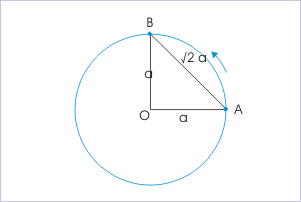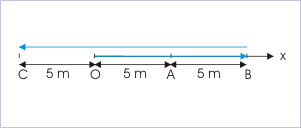| << Chapter < Page | Chapter >> Page > |
Therefore, what we mean by the inequality emphasized earlier is that change in the magnitude of position vector, "r”, is not equal to the magnitude of change in the position vector. In order to appreciate the point, we can consider the case of two dimensional circular motion. Let us consider the motion from point "A" to "B" along a circle of radius "a", as shown in the figure.
Circular motion

Since radius of the circle remains same, the change in the magnitude of position vector,"r", is zero during the motion. Hence,
However, the magnitude of displacement during the motion is :
Hence, the magnitude of change in the position vector is :
Clearly,
Further, | r | represents the magnitude of position vector and is equal to “r” by conventional meaning. Hence,
Therefore,
This completes the discussion on similarities and differences among the four symbols. But, the question remains why there are differences in the first place. The answer lies in the fact that position vector is a vector quantity with directional property. It means that it can change in either of the following manner :
Thus we see that it is entirely possible, as in the case of circular motion, that change in position vector is attributed to the change in direction alone (not the magnitude). In that case, Δr and |Δ r | are not same. We can see that such difference in meaning arises due to the consideration of direction. Will this difference persist even in one dimensional motion?
In one dimensional motion, representations of change in position vector and displacement are done with equivalent scalar system. Let us examine the meaning of equivalent scalar terms. Here, the change in the magnitude of position vector "r" is equivalent to the change in the magnitude of position vector, represented by scalar equivalent "|x|". Also, the magnitude of change in the position vector “ r ” is equivalent to the magnitude of change in the position vector, "x" (note that signed scalar "x" denotes position vector).
Let us consider the case of a rectilinear motion (motion along a straight line) taking place from from A to B to C. The magnitude of change in the position vector, “x”, considering “O” as the origin is :
Rectilinear motion

Now, the change in the magnitude of position vector, “|x|”, is :
Thus we see that difference in two terms exist even in one dimensional motion. This is expected also as one dimensional motion can involve reversal of direction as in the case considered above. Hence,
Let us now consider unidirectional one dimensional motion like uniform motion in which velocity is constant and particle moves in only one direction. In this case, this difference disappears and
The discussion here on this subtle difference is very important as this becomes an important consideration subsequently with velocity and acceleration as well, which are defined in terms of position vector.
Problem : The displacement (x) of a particle is given by :
At what time from the start of motion is the displacement maximum?
Solution : The displacement (x) depends on the value of sine function. It will be maximum for maximum value of sin(wt + θ). The maximum value of sine function is 1. Hence,
The motion is oscillating as expression for displacement is sinusoidal. The particle will attain maximum displacement at regular intervals.

Notification Switch
Would you like to follow the 'Physics for k-12' conversation and receive update notifications?